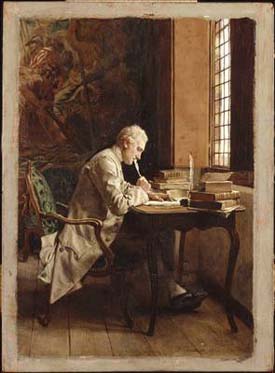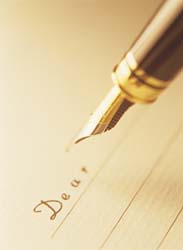 |
Formation of Children
Writing Letters
Marian T. Horvat, Ph.D.
In this age of fast messaging with e-mails and other electronic devices, the art of letter-writing is being lost. This is most unfortunate. Every well-bred young man should know how to write a letter, and have the proper writing materials to do so. There is no substitute for the handwritten thank-you letter, condolence letter, or nicely scripted invitation, acceptance or regret.
The letter is a written conversation, realized through space and time. It should be a genuine expression of the mind and heart.
The essential quality of a letter is authenticity, in expression as well as general style. This quality and a good tone reveal the character and culture of the one who writes, just as a badly written letter is a testimony of an uncultured man.
Presentation is important
The letter you write is always a mirror that reflects your appearance, taste and character. A sloppy letter with bad spelling, slanting lines, and perhaps even a blot or two reveals the kind of person who is messy, disordered and undisciplined. A neat finely written letter, on the other hand, is most likely from the hand of the orderly and well disciplined young man.

The letter your write reflects your taste and character |
The best external adornment of a letter is simple, clean, good quality paper that is properly formatted. That is, the top and bottom of the paper and a left margin should be left blank.
If a letter extends to four pages, the writing on each page should be vertical; do not use extravagant styles such as alternating the pages with horizontal and vertical writing. Another bad habit is to scrawl extra notes anywhere on the pages. These can be present in your draft, but not in the final letter. If two pages are insufficient, add the appropriate numbers in the upper right hand corner; there is no need to number the first page.
If a boy has difficulty writing in a straight line, he can place a lined paper under his stationery in order to keep his handwriting even and straight. If this recourse does not work, it is acceptable to use a lined writing paper. The sender should be aware, however, that a lined paper considerably diminishes the level of a letter.
Writing paper for a man should be conservative. Plain white, gray and granite are the normal colors acceptable. It reveals good taste and appreciation for your correspondent to have your paper engraved with your full name. Before the age of computers, such stationery was made in special printing houses with fine, elaborate fonts and embossed lettering. Today, one can make a very acceptable stationery using the home computer.

Writing with a fountain pen adds a distinguished tone to a letter |
The practice of engraving the person’s name varies according to cultural habits. In the United States the engraving is generally in the center top of the page; in European countries it is placed on the top left.
The ink color should be blue or black for men. To express consideration for your correspondent, write with a fountain pen. Today the ballpoint pen has invaded everywhere, and is also admitted in formal letters. If you are writing to someone who understands the rules, however, use the fountain pen. It will earn you his respect.
The envelopes should harmonize with the paper. Do not use varied colors, for example, a red envelope with white paper.
Letters should be properly dated. Usually the date is put at the upper right hand of the first page of a letter, or at the end and to the left of the signature in a note. The date should be written March 3, 2008, and not 3-3-08.
A letter should be written with a good, legible handwriting. An undecipherable letter is discourteous because it shows that one prizes neither the time nor the patience of the reader.
The letters should be well-formed in a script hand, giving proper height to the letters l, b, d, and f, and not omitting any punctuation mark.
To have a clean, well-composed letter, follow the wise practice of writing a first draft. Then, after re-reading it and making changes and corrections, pen the final letter in a neat hand. This good custom should be taken up from a young age, and continued as an adult.
Once your letter is ready, carefully make a single or double fold depending on the format of the paper and envelope, but in such a way that the first page of the letter is on the inside rather than the outside of a letter of more than one page. A letter loses much of its good first effect by a sloppy folding job.
Addressing the envelope merits special attention, not only so that the letter arrives at the proper place, but also because its will make the first good – or bad – impression on the one receiving it. Take care, then, to write the address in an exact and very legible hand.
It is always possible to improve

Marshal Foch made a strong effort to improve his handwriting, and succeeded |
As a young man, Marshal Ferdinand Foch, who commanded the Allied armies in France in World War I, had a terrible handwriting. However, paying heed to the advice given him, he came to write so neatly that his letters seemed typed. One can see that this great Catholic man did not admit the formula “I can’t.”
Style and content
What we have said until now, while rigorously pragmatic, is only the wrapping of the package. Inside is the gift: the sentiments and thoughts that one person wants to reveal to another.
The supreme rule is to consider the person to whom one is writing: the age, authority, social position and relationship to the writer. Keeping this in mind and the matter being addressed, the letter will burgeon naturally, relying on our sense of propriety and good manners.
That is to say, if a youth is addressing an authority, such as a priest or professor, he should maintain a formal and polite tone. Speaking to his grandmother or uncle, he may use a warmer style, but should keep the respectful and courteous manner in writing. In addressing letters to his friends, he may assume a more informal style, but he should never use slang or the vulgar expressions so common among youth today. This is particularly important in letters addressed to ladies.

St. Paul writing a letter, which is delivered to the Corinthians |
Prolix and pretentious phrases should be avoided. Instead of impressing, the writer only appears ostentatious and vainglorious.
Always remember that the wounds that come from the pen from rude and uncivil language are gashes from the sword. They can leave indelible scars on the soul. And they can be mortal to a friendship. Exercising prudence in what you say in letters is the safeguard of friendships. Even in a letter that expresses disapproval, the terms should be imbued with gentility. It is good to compose one’s words in a letter in such a way that it could be read not only by one to whom it is addressed, but also by other persons. In general a letter should contain nothing that does not merit public display. The same care should be taken with regard to e-mails.
The salutations, letter form, and closings are things taught in elementary school. A good teacher makes an effort to develop a good letter style in his students.
Formal addresses and closings
Here are some samples of written salutations and closings that were used in the past in formal letters. It is advisable to revive the practice of more formal and respectful salutations and closings.
To the Pope:
Written Address: The Sovereign Pontiff, Your Holiness Pius XII.
Letter Salutation: Your Holiness Pius XII,
Formal Closing: On my knees before Your Holiness, protesting my filial dedication and imploring the favor of an apostolic blessing, I have the honor to be,
The humble and obedient Servant of Your Holiness,
(Signature)
To a Cardinal:
Written Address: His Eminence, Thomas Cardinal Stand, Archbishop of Los Angeles,
Letter Salutation: Your Eminence, Formal Closing: Be pleased to accept the homage of profound respect with which I have the honor to offer you as,
The humble and dedicated servant of Your Eminence,
(Signature)
For an Archbishop or Bishop, the same formula can be employed with the substitution of His Excellency and Your Excellency for His Eminence and Your Eminence.
To a person of high station or stature:
Written Address: The Hon. John Glover Roberts, Jr.
Written Salutation: Dear Sir, or Sir,
Formal Closing: I ask Your Excellency (Your Honor) to accept my profound respect. I remain
Your humble and obedient servant,
Or, I have the honor to remain,
Yours faithfully,
(Signature)
To all priests or religious, use formulas such as:
Written Address: The Reverend Father John W. Butler, The Reverend Mother Ann Francis, O.S.B., or Sister Anthony Christine, O.P.
Letter Salutation: Dear Father, or Dear Rev. Mother,
Formal Closing: Receive the expression of my respect,
Or, Receive my sentiments of filial respect,
Or, Offering my respectful homage,
Most respectfully,
(Signature)
To a person of medium dignity, close:
With great respect and consideration, I remain,
Or, Most respectfully,
Or, Most faithfully,
(Signature)
Between persons of equal or almost equal status, close:
Offering my consideration and esteem, I have the pleasure to be,
Your attentive and grateful friend (or colleague),
Or, Sincerely,
Or, Faithfully,
(Signature)
To closer friends or relatives, close:
I have the great satisfaction to sign myself,
Your loyal friend,
Or , Your devoted grandson,
(Signature)
For a parent:
I close, signing with the greatest respect,
Your loving and obedient son,
(Signature)

Posted February 11, 2008

Related Topics of Interest
 How to Address Priests and Religious How to Address Priests and Religious
 Amiability Amiability
 The Braggart The Braggart
 The Value of Distinction The Value of Distinction
 Let's Not Forget the Greeting Let's Not Forget the Greeting
 The Blessing The Blessing
 The Family Milieu The Family Milieu
 A Youth's Relations with His Superiors A Youth's Relations with His Superiors
 Proper Behavior for Visits - Part I Proper Behavior for Visits - Part I

Related Works of Interest
|
|
Formation | Cultural | Home | Books | CDs | Search | Contact Us | Donate

© 2002- Tradition in Action, Inc. All Rights Reserved
|
 |
|